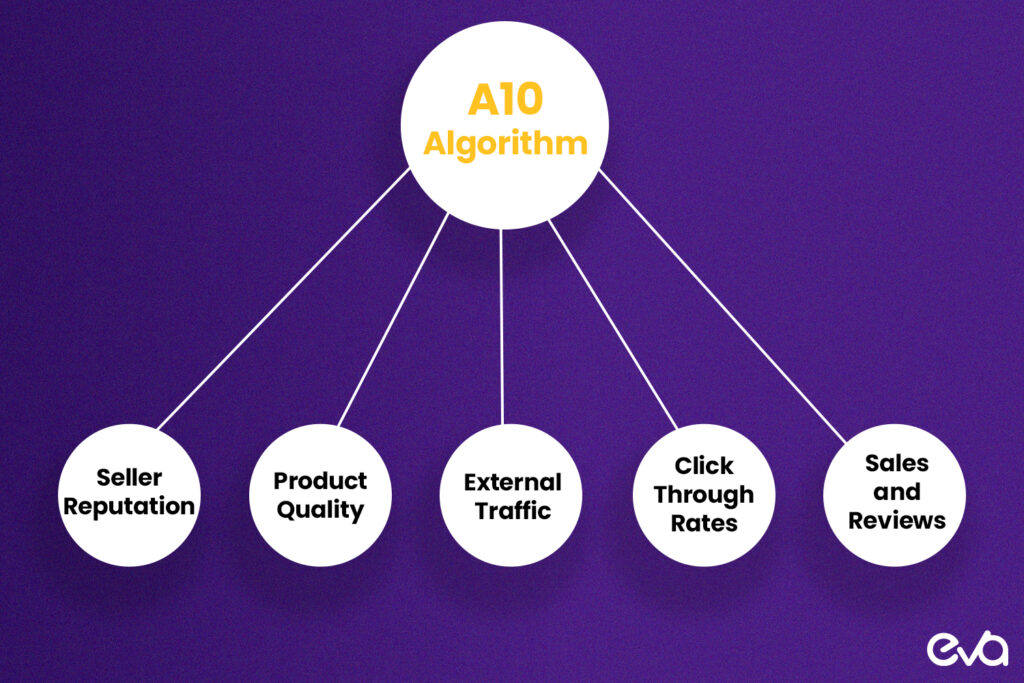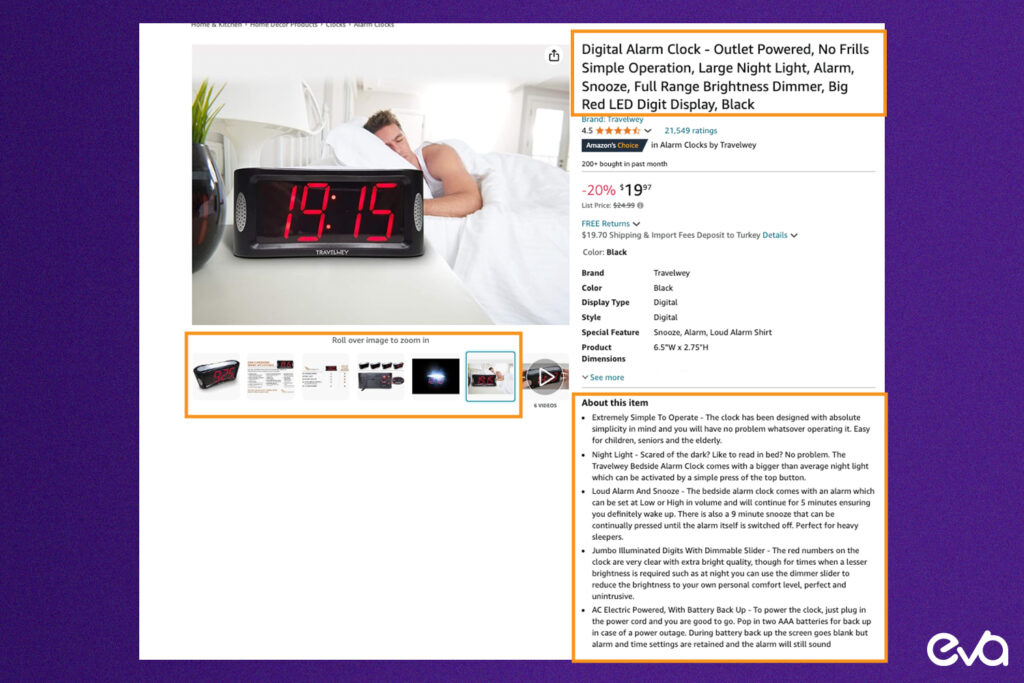Table of Contents
Introduction to Amazon’s Search Algorithms
Understanding Amazon’s search algorithms is crucial for anyone involved in Amazon selling and advertising. These algorithms play a key role in determining how products are ranked and displayed on Amazon, influencing visibility and sales.
What Are Amazon’s Search Algorithms?
Amazon’s search algorithms are complex systems used to determine the order in which products appear in search results and on product pages. These algorithms analyze various factors to decide which products are most relevant to a user’s search query.
- Algorithm Versions: Amazon has evolved its search algorithms over time. Initially, Amazon used the A9 algorithm, which was later succeeded by the A10 algorithm. Each version brings changes to how product rankings are determined.
- Functionality: The algorithms process user search queries, match them with relevant product listings, and rank these listings based on relevance and other factors. The goal is to provide users with the most relevant and useful search results.

Importance of Search Algorithms in Amazon Advertising
Search algorithms are fundamental to Amazon advertising because they directly impact how ads and product listings are displayed to users.
- Visibility and Ranking: A higher ranking in search results means greater visibility for your products. This visibility can lead to more clicks, higher conversion rates, and increased sales. The search algorithms determine which products appear at the top of search results, making them crucial for advertisers who want to improve their product’s exposure.
- Advertising Strategies: Understanding how the search algorithms work helps advertisers tailor their strategies to align with these algorithms. This includes optimizing product listings, managing bids, and targeting ads effectively to ensure they perform well under the current algorithm.
- Impact on Sales: The way products are ranked affects their sales performance. Effective use of the algorithms can lead to better ad placements and more successful campaigns, which in turn drive higher sales and revenue.
Overview of Amazon A9 Algorithm
The Amazon A9 algorithm was the primary system used for ranking products on Amazon before the introduction of A10. Understanding how it functioned helps in appreciating the changes brought by the newer algorithm.
What is the A9 Algorithm?
The A9 Algorithm was Amazon’s search and ranking system that determined which products appeared in search results and product listings.
- Purpose: Its main purpose was to rank products based on their relevance to the search query and other ranking factors, ensuring users saw the most pertinent results for their searches.
- Focus: A9 primarily focused on matching keywords from search queries with product titles, descriptions, and other attributes to determine relevance.
How A9 Algorithm Works
How A9 Algorithm Works involves several key processes and factors:
- Keyword Matching: A9 matched search queries with product listings based on keywords found in titles, bullet points, descriptions, and backend search terms.
- Relevance Score: Products were given a relevance score based on how closely they matched the search query and how well their content aligned with the keywords.
- Sales Performance: Products with higher sales volumes and conversion rates were ranked higher, as A9 considered past performance as an indicator of relevance and quality.
Key Factors Influencing A9 Algorithm
Key Factors Influencing A9 Algorithm included:
- Keyword Relevance: The presence and prominence of relevant keywords in product listings played a significant role in ranking.
- Sales History: Products with strong sales history and higher conversion rates were favored.
- Customer Reviews: Positive customer reviews and ratings influenced rankings by reflecting the product’s quality and customer satisfaction.
- Click-Through Rate (CTR): Higher CTR indicated that users found the product listings appealing and relevant, affecting rankings.
Overview of Amazon A10 Algorithm
The A10 algorithm represents a more recent evolution in Amazon’s search ranking system, introducing new factors and adjustments to improve the search experience.
MUST READ: All You Need To Know About Amazon A10 Algorithm
What is the A10 Algorithm?
The A10 Algorithm is Amazon’s latest search ranking system, designed to enhance product discovery and relevance.
- Purpose: A10 aims to provide more accurate and user-centric search results by incorporating advanced data analysis and machine learning.
- Focus: It shifts focus towards user behavior, engagement metrics, and refined relevance scoring to better match users with the products they are most likely to purchase.
How A10 Algorithm Works
How A10 Algorithm Works involves several updated processes:
- User Behavior Analysis: A10 places significant emphasis on user behavior, such as click-through rates, time spent on product pages, and engagement metrics.
- Relevance and Sales Performance: While still considering keyword relevance and sales performance, A10 incorporates additional data points to refine rankings.
- Personalization: A10 uses machine learning to personalize search results based on individual user preferences and past behaviors.
Key Factors Influencing A10 Algorithm
Key Factors Influencing A10 Algorithm include:
- User Engagement: Metrics such as click-through rates, time on page, and interaction with the product listings are crucial for ranking.
- Conversion Rates: High conversion rates and strong sales performance remain important, but A10 evaluates them in conjunction with other user engagement metrics.
- Content Quality: Enhanced focus on the quality and relevance of product content, including how well it meets user intent and query relevance.
- Personalization: A10 takes into account personalized user preferences and browsing history to tailor search results more effectively.
Comparison Between A9 and A10 Algorithms
Understanding the evolution from Amazon’s A9 to A10 algorithms is essential for optimizing your Amazon strategy. The shift from A9 to A10 brings several notable changes in how products are ranked and displayed.
Major Differences Between A9 and A10
Major Differences Between A9 and A10 highlight the evolution in Amazon’s search algorithms:
- Focus Shift: A9 was heavily focused on keyword relevance and historical sales data. In contrast, A10 places greater emphasis on user engagement and behavior metrics, such as click-through rates and time spent on product pages.
- Personalization: A10 introduces a higher level of personalization, using machine learning to tailor search results based on individual user preferences and browsing history, whereas A9 had a more general approach.
- Algorithm Complexity: A10 is more complex and dynamic, incorporating advanced data analysis and AI-driven insights, while A9 relied more on straightforward keyword matching and sales performance.
Changes in Ranking Factors
Changes in Ranking Factors between A9 and A10 have significant implications:
- User Engagement Metrics: A10 adds weight to user engagement metrics such as click-through rates (CTR), page views, and time spent on listings. This shift means that products that engage users more effectively are likely to rank higher.
- Relevance Scoring: While A9 focused on keyword relevance and sales history, A10 uses a more holistic approach, including user behavior and content quality. This makes relevance scoring more nuanced and reflective of actual user interactions.
- Sales Performance: Sales history and conversion rates still play a crucial role in A10, but they are considered alongside other factors like user engagement, making the algorithm’s approach more balanced and less dependent on past performance alone.
Impact on Product Listings and Ads
Impact on Product Listings and Ads reflects the practical effects of these algorithm changes:
- Product Listings: Sellers need to optimize their product listings with high-quality content and keywords that not only match user searches but also engage users. Enhanced product descriptions, images, and customer reviews become increasingly important under A10.
- Advertising Strategies: With A10, advertising strategies should focus on driving engagement and improving user interactions with product ads. This includes optimizing ad copy, targeting relevant keywords, and using data-driven insights to enhance ad performance.
- Visibility and Ranking: Products that engage users and perform well in terms of CTR and conversion rates are likely to see better visibility and higher rankings under A10. Sellers must adapt their strategies to prioritize user engagement alongside traditional optimization techniques.

How the A10 Algorithm Affects Amazon Sellers
The shift from Amazon’s A9 to A10 algorithm brings significant changes that affect how sellers approach product listings and advertising strategies.
Implications for Product Listings
Implications for Product Listings with the A10 algorithm include:
- Enhanced Focus on Engagement: Sellers must create compelling product listings that not only include relevant keywords but also engage users effectively. This means prioritizing high-quality images, detailed descriptions, and addressing customer pain points to keep users interested.
- Improved Relevance: Listings should be optimized to match user intent more accurately. A10’s emphasis on relevance scoring means that having well-structured and relevant product information is crucial for higher rankings.
- Content Quality: High-quality content, including informative product descriptions and customer reviews, becomes more important. The A10 algorithm rewards listings that provide a better user experience and meet customer needs more effectively.
Effects on Advertising Strategies
Effects on Advertising Strategies due to the A10 algorithm:
- Increased Importance of Engagement Metrics: Advertisers need to focus on improving metrics such as click-through rates (CTR) and engagement levels. Ads should be designed to attract attention and encourage user interaction.

- Targeting and Personalization: With A10’s emphasis on personalization, ads should be tailored to specific user preferences and behaviors. Leveraging data to target ads effectively can lead to better performance and higher ROI.
- Ad Copy and Creative: Effective ad copy and creative are crucial under A10. Ads should not only include relevant keywords but also resonate with users on an emotional level to boost engagement.
Adapting to the New Algorithm
Adapting to the New Algorithm involves:
- Understanding New Metrics: Familiarize yourself with the new user engagement metrics that influence rankings. Adjust your strategies to focus on these metrics to stay competitive.
- Optimizing Listings and Ads: Continuously optimize product listings and ads based on performance data. Regularly review and adjust content, keywords, and ad strategies to align with A10’s focus on user engagement and relevance.
- Staying Informed: Keep up with Amazon’s updates and changes to ensure your strategies remain effective. Adapting quickly to algorithm changes can help maintain and improve your visibility and performance.
Navigating both the A9 and A10 algorithms requires a strategic approach to optimize product listings and advertising efforts effectively.
Optimizing Product Listings for A9
Optimizing Product Listings for A9 includes:
- Keyword Optimization: Ensure that product titles, bullet points, and descriptions are rich with relevant keywords.
- Sales and Conversion: Focus on driving sales and improving conversion rates, as A9 prioritized these factors.
- Customer Reviews: Enhance product visibility by gathering positive reviews and ratings.
Adapting to A10: New Strategies and Techniques
Adapting to A10: New Strategies and Techniques involves:
- Engagement Optimization: Improve user engagement by creating interactive and appealing product listings.
- Personalization: Use data-driven insights to tailor product listings and ads to individual user preferences.
- Performance Tracking: Monitor metrics such as CTR and engagement rates to refine strategies and boost performance.
Leveraging Data and Analytics for Success
Leveraging Data and Analytics for Success includes:
- Performance Analysis: Regularly analyze performance data to understand what works and what needs adjustment.
- Data-Driven Decisions: Use insights from analytics to make informed decisions about product listings and ad strategies.
- Continuous Improvement: Implement changes based on data findings to continuously improve your Amazon performance.
Future Trends and Predictions
Looking ahead, understanding emerging trends can help you stay ahead in the competitive landscape of Amazon selling and advertising.
Evolving Algorithms: What to Expect
Evolving Algorithms: What to Expect involves:
- Increased Use of AI: Future algorithms will likely leverage more advanced AI and machine learning techniques to refine search and ranking processes.
- Enhanced Personalization: Expect even more sophisticated personalization based on user behavior and preferences.
- Greater Focus on User Experience: Algorithms will continue to prioritize user experience, including faster load times and more relevant search results.
Preparing for Future Updates
Preparing for Future Updates includes:
- Staying Flexible: Be prepared to adapt your strategies as Amazon releases new algorithm updates and features.
- Continuous Learning: Keep up-to-date with Amazon’s announcements and industry trends to anticipate changes and adjust accordingly.
- Investing in Tools: Utilize advanced tools and technologies to stay ahead of algorithm changes and optimize your Amazon strategies effectively.
How EVA Can Help
At EVA, we offer comprehensive solutions to navigate the complexities of Amazon’s algorithms and optimize your selling strategy:
- Amazon SEO: Our expert team enhances your product listings with keyword-rich content and SEO best practices, ensuring your products rank higher under both A9 and A10 algorithms.
- Listing Optimization: We provide detailed optimization services to improve your product titles, descriptions, and images, boosting relevance and engagement.
- Advanced Analytics: Our powerful AI platform offers real-time data analysis, helping you understand performance metrics and adapt your strategies for optimal results.
- Expert Guidance: With industry-leading expertise, we guide you through the changes in Amazon’s algorithms, ensuring your strategies are always aligned with the latest trends and best practices.
Conclusion
In this blog post, we’ve explored the significant changes brought by Amazon’s transition from the A9 to the A10 algorithm. Understanding these updates is crucial for optimizing your product listings and advertising strategies on Amazon.
Summary of Key Points
- Algorithm Evolution: The shift from A9 to A10 represents a move towards more user-centric search results. A10 emphasizes user engagement, personalization, and advanced data analysis, whereas A9 focused on keyword relevance and sales history.
- Impact on Sellers: A10 affects how products are ranked and displayed, requiring sellers to enhance their product listings and advertising strategies. Engaging content, personalized ads, and improved user interaction are now more critical for success.
- Best Practices: Optimizing product listings for A9 involved keyword-rich content and strong sales performance. For A10, focusing on user engagement, leveraging data-driven insights, and adapting to new metrics is essential.
- Future Trends: Anticipate further advancements in AI and personalization, and be prepared to adapt your strategies to future algorithm updates to maintain a competitive edge.
Final Tips for Sellers
- Stay Informed: Keep up with Amazon’s updates and algorithm changes to adjust your strategies accordingly.
- Optimize Listings: Regularly refine your product listings to enhance relevance and user engagement.
- Leverage Data: Use data analytics to understand performance metrics and make informed decisions.
- Adapt Strategies: Be flexible and ready to adapt your advertising and optimization strategies to align with the latest algorithm updates.
FAQ
The Amazon A9 algorithm, used before the introduction of A10, focused heavily on keyword relevance and historical sales data. In contrast, the A10 algorithm emphasizes user engagement metrics such as click-through rates, time on page, and personalized search results based on individual user behavior and preferences.
The A10 algorithm impacts product rankings by incorporating more user-centric factors. It considers engagement metrics like how users interact with product listings and ads, as well as personalization based on browsing history. This shift means that products with higher user engagement and relevance to individual preferences are likely to rank higher.
he A10 algorithm takes into account several factors, including user engagement metrics (click-through rates, time on page), personalization based on user behavior, the quality of product content, and overall sales performance. It aims to provide more personalized and relevant search results to users.
To optimize listings for the A10 algorithm, sellers should focus on enhancing user engagement. This includes creating high-quality, engaging product content, using data to personalize listings and ads, and improving metrics such as click-through rates and conversion rates. Regularly analyzing performance data and adapting strategies based on user behavior are also crucial.
Yes, there are tools and services designed to help with A10 algorithm optimization. Services like EVA offer Amazon SEO, listing optimization, and advanced analytics to help sellers adapt to algorithm changes and improve their performance on Amazon. These tools can assist in optimizing product listings, tracking performance metrics, and refining advertising strategies.









